5 Steps of Supervisor Coaching Effectiveness
Most call center supervisors struggle with how to coach their agents effectively to help them improve their first call resolution (FCR) and customer satisfaction (Csat) performance. Furthermore, the success of your call center customer service depends on your supervisor's agent coaching effectiveness for improving and sustaining high FCR and Csat performance. Unfortunately, one of the biggest complaints we hear from agents is their supervisor has not been able to help them improve Csat. Therefore, this blog will focus on the Five Steps for Improving Call Center Supervisor Coaching Effectiveness for Helping Agents Deliver Great Csat.
Discover the following:
- Coaching System – goals, techniques, and technology
- Training of the Coach – tips for supervisors for coaching agents to improve Csat
- Interpersonal Skills – required to inspire and motivate to achieve high Csat
- Coaching Activity Reporting – to provide visibility of supervisor coaching activities
- Coaching Effectiveness – the % of agents who improved Csat after being coached
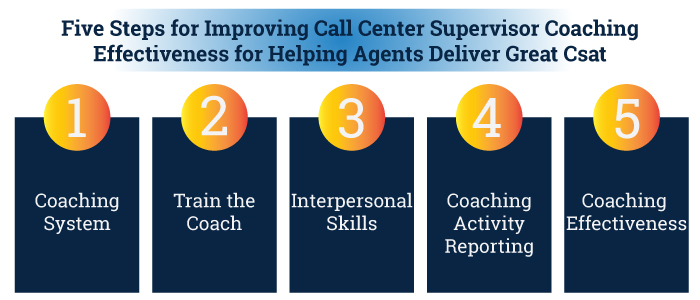
1. Coaching System
This section covers goals, techniques, and technology to achieve high Csat.
SMART Goal
Many call centers that want to improve supervisor coaching effectiveness for helping agents deliver great Csat start with SMART goals. Goal setting allows agents to understand expectations and progress towards the goals clearly and ensures that coaching is more productive. The SMART Goal acronym stands for Specific, Measurable, Attainable, Relevant, and Time-Based. The following is information on how supervisors can use SMART goals for coaching agents to improve Csat and call resolution key performance indicators (KPI).
- Specific: Your agents clearly understand their goals and can quickly recognize if they are on track to achieving the goal. Having clear goals is far better, and there is a more likelihood of achieving the goal than vague or abstract Csat and customer service goals. Furthermore, during coaching sessions, use the 5 W's (what, why, who, where, when, and how) to ensure agent clarity of goal metrics.
- Measurable: This means the goal is measurable, and an agent can understand their progress towards the goal. It also means that the goal is tangible and, therefore, there is more likelihood of agents being able to achieve it. When agents are given a dashboard tool, they can measure their progress in achieving the goal.
- Attainable: You need to set goals that agents can realistically obtain. When you set the agent goal, you must consider current resources, tools, knowledge, procedures, policies, products, services, and their recent Csat performance. After you reflect on these areas, you might think the goal is unrealistic or too easy to obtain, or you got it right.
- Relevant: Your agents should fully understand and align with the purpose behind the Csat goal. Therefore, agents need to know how the goal is aligned with your company's vision, mission, values, and enterprise goals.
- Time-Based: Lastly, your performance Csat goal needs a target date for achieving the goal. A target date or deadline goal adds an element of urgency to agency behaviors for achieving the goal.
Using a SMART goal approach during agent coaching sessions can be an effective systematic way to consistently ensure all agents align with the 5 W's and how during coaching sessions. Below is a SMART goal example for Csat that can be used for supervisor coaching sessions.
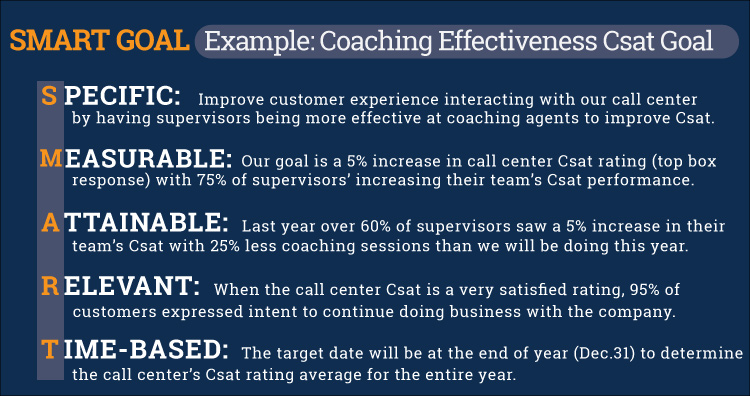
Six Coaching Techniques
SQM experience shows that 1:1 agent coaching is one of the most reliable ways for an agent to understand their strengths that they can build upon and weaknesses that need to be addressed to improve their Csat ratings. The following are six techniques a supervisor can use to coach agents effectively:
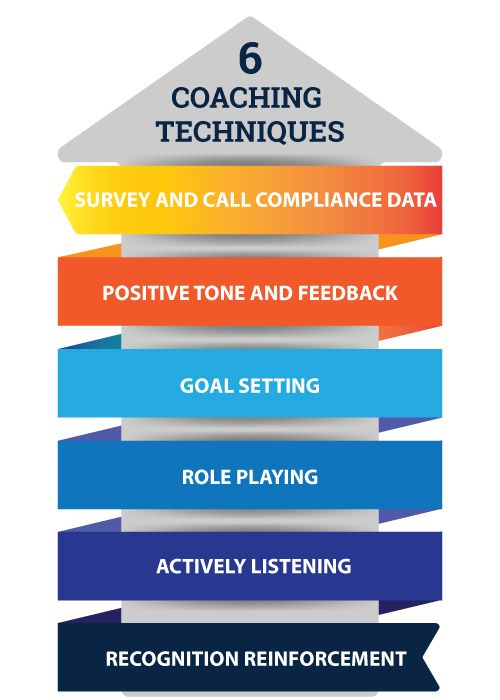
1. Survey and Call Compliance Data
Customer Quality Assurance (CQA) combines call compliance metrics, judged by a QA evaluator, and service quality metrics, judged by a customer via a post-call or email customer survey to evaluate the same call. CQA provides a holistic approach for delivering CX insights. CQA is based on letting the customer be the judge of their experience when using a call center and is one of the best practices for coaching agents to improve their Csat rate. Agents value using survey and call compliance data from the same call to help them improve their Csat delivery because there are areas that QA can judge more effectively and areas that the customer can judge more effectively. See SQM's CQA Form.
2. Positive Tone and Feedback
Supervisors must have a positive tone for agents to be receptive to constructive feedback about improving their Csat performance. It is helpful to start the coaching session with positive feedback, then constructive or negative feedback, and close the session with positive feedback. During the coaching session, use the agent's own Csat data for providing positive and negative feedback. Doing so makes the coaching session more sincere and meaningful for agents.
3. Goal Setting
Agent goal setting should be a collaborative approach. If the agent is not engaged in the goal setting, they are likely not to be committed to achieving the Csat performance. In addition, the Csat improvement goal must be attainable. For example, a conservative Csat (top box response) rating improvement goal is 1% to 2%, a moderate Csat improvement goal is 3% to 4%, and an aggressive Csat improvement goal would be 5% or more. Unfortunately, only 5% of SQM client call centers achieve a 5% increase in overall Csat annually. Once the agent goal is agreed upon, you are ready to discuss and develop an action plan to achieve the Csat goal.
4. Role Playing
Agent role-playing is a customer service exercise where agents practice call handling techniques for specific call reasons, with a fellow agent or supervisor acting as the customer. In addition, role-playing with other agents or the supervisor for call handling certain call types in a safe, learning environment – makes it much easier to put new skills into practice before doing it with customers. Agent role-playing is often used in training or when implementing new pricing, products, services, and policies but can be an effective Csat coaching technique.
5. Actively Listening
It is often said that great coaches are great listeners. For a supervisor to be a great coach, they need to be an active listener (e.g., pay attention, probe, clarify, and confirm) to ensure understanding of what an agent said and respond to what was said. Repeating some of the keywords they mentioned conveys the message that you understand what they have expressed. Active listening keeps both agent and supervisor actively engaged in the conversation. Furthermore, asking an agent to self-assess how they handled a specific call helps ensure productive coaching sessions. Doing so allows the supervisor to actively listen and collaborate with an agent to develop ways to improve their Csat.
6. Recognition Reinforcement
After the agent coaching session, monitor calls for the next few days and look for opportunities where the agent demonstrated the new skills they learned from the coaching session. Moreover, share the recording and video with the agent as soon as possible. By doing so, you recognize and reinforce the agent's new skills being used on the call. In addition, agents feel the supervisor is paying attention to improving their skills and, as a result, will inspire and motivate them to continue to use those new skills and develop even more new skills.
Technology
Since 1996, SQM Group has connected customer feedback and QA to agent performance, coaching, and recognition to improve CX using a call center. Our mySQM™ Customer Service QA software empowers, recognizes, and engages agents by providing them with real-time dashboard reporting for customer feedback, quality assurance, coaching, and recognition to deliver great CX. In addition, real-time actionable notifications (e.g., great CX delivery and service recovery opportunities) are pushed out to agents and supervisors. Our software captures data from multiple sources (e.g., post-call survey, QA, call data) and stores it in one fully integrated software platform for managing CX data to deliver great customer satisfaction.
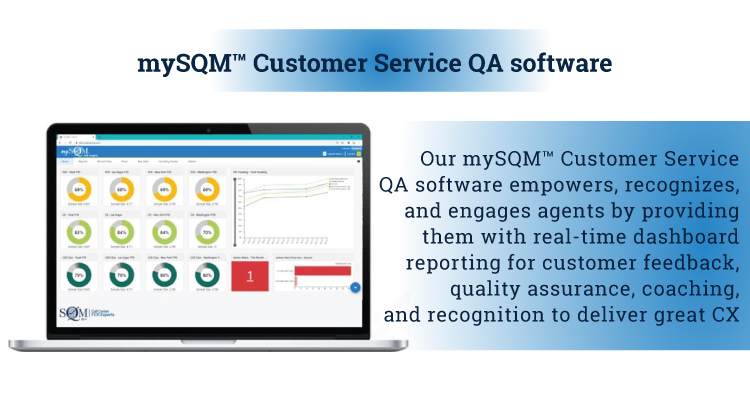
The workflow below is to ensure supervisor and agent coaching sessions are productive. How the workflow works are the supervisor determines what information is necessary for an effective coaching session for a specific agent situation. Furthermore, the agent coaching workflow ensures that coaching sessions are more consistent among supervisors.
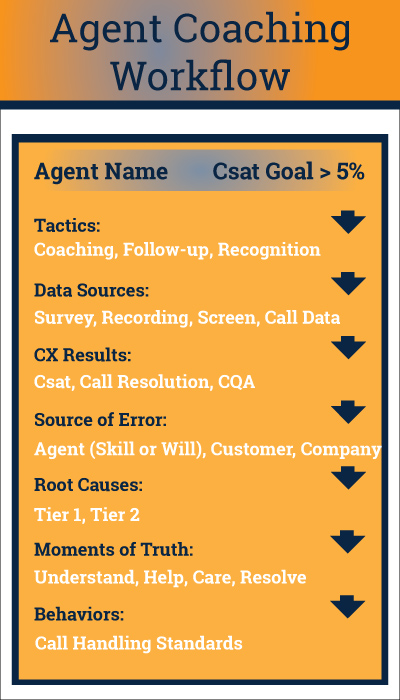
The agent coaching workflow starts with tactics such as the supervisor conducting a coaching session, follow-up from a previous coaching session, or recognizing positive Csat results or behaviors. For agent coaching, data sources typically include surveys, recording, screen capture, and call data to support the coaching. CX results (e.g., Csat call resolution, CQA) are concrete data. CX result data lets agents quantify their strengths and weaknesses to determine improvement opportunities.
As part of the workflow process, the source of error (SoE) for a call that was not resolved is identified. For example, was the SoE the agent, the customer, or the company, and if it was the agent, was it a will or skill issue? Furthermore, the root causes are identified using a tier tagging system. For example, if a repeat call were a billing issue, tier 1 is tagged as billing, and tier 2 is the specific issue (e.g., incorrect, payment, unclear). The tagging helps identify trends.
The final elements of workflow are moments of truth (MoT), such as the agent understanding the customer's needs, helping them, caring about the situation, and, most importantly, resolving their inquiry or problem. MoT provides agents with powerful insights from the customer's perspective. The agent behaviors identified are based on SQM's call handling standards and the QA or supervisor's opinion of the behavior they want the coaching session to address.
The agent coaching workflow's primary purpose is to ensure that agents receive consistent coaching and productive coaching sessions. Furthermore, it is essential to emphasize that supervisor coaching effectiveness should be based on the percentage of agents achieving the Csat goal or improving their Csat. The agent coaching workflow process can be valuable for supervisors to help their agents improve Csat.
2. Training of the Coach
This section covers training tips for supervisors on how to coach agents to improve Csat.
In many cases, managers promote their best agents to be supervisors without equipping them with the necessary training to be effective coaches for helping agents improve Csat. Yet, a good coach plays a big role in assisting an agent to become a long-term high Csat performer. Therefore, we have provided five training tips to keep in mind for supervisors to become better at coaching agents to improve Csat.
1. Agents Receive Csat Coaching at Least Once Every Month
One of the most common complaints we hear from agents is that their monthly coaching sessions always get canceled. It is SQM's view that agents must get coached at least once every month, and the coaching session is approximately one hour long, so they can keep improving their knowledge and skills.
2. Use an Agent Coaching Workflow
Other common complaints we hear from agents are that their supervisor is ineffective at coaching them to improve Csat or the supervisors are inconsistent on how they coach agents to improve Csat. As previously mentioned, a way to remedy those agent complaints is to use an agent coaching workflow.
3. Coach all Agents
Traditional thinking is that when call center overall Csat improves, it comes from improving agents in the 3rd and 4th quartile Csat performance levels. As a result, supervisors have allocated more agent coaching time to improve agent Csat performance with the lowest Csat agent performers. At SQM, we recommend that supervisors invest approximately 50 to 75% of their coaching time with 1st and 2nd quartile Csat performing agents and 25 to 50% of their time with 3rd and 4th quartile Csat performing agents. In most cases, supervisors should allocate most of their time coaching with 1st and 2nd quartile performing Csat agents to help improve a call center's overall Csat. Furthermore, by focusing on 1st and 2nd quartile performing Csat agents, it is more likely the call center's overall Csat will improve.
4. One-on-One Coaching Sessions
Team coaching sessions are practical for sharing opportunities for Csat improvement that impact all agents but are inappropriate for coaching an agent's specific needs in a team meeting. One-on-one coaching allows a supervisor to discuss performance privately, which is more conducive to a productive coaching session. Before the coaching session, give the agent access to the performance data the supervisor will use and time to review it. Then before the supervisor shares their thoughts about the agent's performance, allow the agent to share what they thought they did well and what they could have done better.
5. Discuss Progress for Achieving Csat Goal
After mutually developing an action plan with an agent, the supervisor should discuss the agent's progress in achieving Csat Goal at the next coaching session. If the agent is on track to meeting or exceeding their Csat goals, recognize their success. However, if an agent is not meeting their Csat goal, identify what is hindering them from not achieving it. For example, the agent might need more time, training, coaching, and encouragement. Although, if the agent's Csat performance is severely deficient and all the necessary resources have been made available, it might be required to put the agent on a performance improvement plan (PIP). If the PIP does not help improve the agent's Csat performance, it might be necessary to terminate them. If supervisor coaching of agents is ineffective, we have clients who improve Csat by terminating the bottom 10% of Csat performers. This may be an effective business decision for your call center but can negatively impact customer service or employee morale in the short term.
3. Interpersonal Skills
This section covers interpersonal skills that inspire and motivate agents to achieve high Csat.
SQM research shows that in 2021 the agent turnover rate of 35% is the highest turnover percentage we have ever measured in over 25 years of benchmarking this metric. Furthermore, the number one reason agents leave a call center is the lack of recognition. In addition, in many call centers, one of the main reason reasons why Csat has decreased or has not improved is the high agent turnover. Below are five interpersonal skill tips for inspiring, motivating, and recognizing agents to help them deliver great Csat, increase agent engagement, and lower agent turnover.
Follow these seven tips to improve your interpersonal skills in the call center workplace:
- Be Positive. Teach yourself how to be positive by reminding yourself every day of the good things about your job's positive aspects and how it contributes positively to agents who work in the call center and customers who use it. Agents like working for a positive supervisor. Furthermore, it isn't easy to inspire or motivate agents if a supervisor is not positive.
- Control your Emotions. The call center isn't the place to be overly emotional. Whether you're upset, depressed, or dissatisfied with your job or situation, take a deep breath and control your emotions. Try to express yourself calmly and patiently when in a difficult situation.
- Give Credit. One of the best ways for a supervisor to build trust at the call center is to let the agents know that you appreciate their knowledge and skills. Ask the agent's opinion on making policies, procedures, and technology improvements and give credit where credit is due.
- Show Interest in Your Agents. You work side-by-side with agents for eight hours daily, five days a week; it's only logical that you'll learn something about agents' lives. A supervisor should make it a point to know what's vital to your agents. It will help enhance your relationships with them.
- Practice Active Listening. A supervisor needs to maintain eye contact with the agent, nod their head, and repeat what they say in their own words. As a result, the agent will feel respected, and the supervisor will likely be able to recall the conversation more quickly afterward. In a call center environment, to help the listening agents and supervisors should be able to see each other's facial impressions, so video conferencing is critical for remote coaching.
- Practice Empathy. An effective supervisor focuses on showing empathy and building a rapport to make an emotional connection with an agent. A supervisor needs to put themself in the agent's shoes. This will help you develop empathy for agents, which in turn goes a long way in finding solutions that work for all involved and creating a strong relationship.
- Maintain Strong Relationships. Connect with agents via video conference, chat, and email daily, and face-to-face for meetings now and then. Start each conversation with small talk before discussing business issues. Regular communication is the key to maintaining strong relationships.
4. Coaching Activity Reporting
This section covers coaching activity reporting to provide visibility of supervisor coaching activities.
Few call centers have coaching activity reporting to provide insights into supervisor coaching activities, such as who got coached, when they got coached, how often they got coached, who coached, and what metrics and behaviors they were coaching. Most importantly, as a result of the supervisor's coaching, did the agents improve their Csat performance?
Supervisor coaching activity (e.g., agents are being coached) is not good enough; you need to understand whether coaching is effective. Ideally, you want your quality assurance program and agent coaching to improve your Csat and FCR performance.
The following questions must be asked to assess supervisor coaching effectiveness:
- Are my supervisors prepared to coach?
- How targeted and actionable is coaching?
- Is coaching consistent across supervisors?
- How often do supervisors coach?
Our mySQM™ Customer Service QA software provides supervisor coaching activities for every agent that can be displayed at the individual agent, team, line of business (LoB), and call center level. The benefit of the visibility of the supervisor coaching activity reporting is that it provides tremendous insights into trends for agent coaching activities and supervisor coaching effectiveness.
- Coaching Activity Reporting Provides Insights for:
- Understand supervisor coaching trends (e.g., who, what, when, and how)
- Identify the number of coaching sessions by time frame
- Identify good, average, and poor Csat performing coaches
- Determine which coaching activities need to be improved
- Identifying which supervisors require more training to become a better coach
- Understand SoE, root causes, moments of truth, and behaviors coached
- Understand coaching effectiveness by agent, team, call type, LoB, call center
- Determine activity for coaching, follow-up, and recognition
5. Coaching Effectiveness
This section covers supervisor coaching effectiveness as defined as the % of agents who improved Csat after being coached.
Most call centers do not measure supervisor Csat coaching effectiveness as defined by the % of their agents who improved Csat based on coaching activities. Therefore, it's tricky to improve Csat from SQM's perspective if you do not measure supervisor Csat coaching activity and corresponding Csat results.
Furthermore, do you know how much time your supervisors spend on agent coaching activities prepping to coach, coaching the agents in terms of time and frequencies, following up on coaching, and recognizing improvement? Or whether or not the supervisors are effective for coaching agents to improve Csat? Unfortunately, most call centers don't measure supervisor coaching activity or the ROI. Yet, supervisor coaching effectiveness represents one of the best opportunities to improve Csat and ROI.
The below graph is based on SQM's research on supervisor coaching activities. The data shows that 47% of the supervisor coaching time is for prepping to coach agents, and only 23% of the time is for coaching an agent. It is common for supervisors to spend 2X or more time prepping than coaching agents. Recognizing improvement and follow-up on coaching also have lower supervisor coaching time percentages. The lower time allocation for recognition and follow-up could negatively impact agent engagement and Csat improvement. It seems to me there is an opportunity to reduce prepping time and invest more time in the other areas (e.g., coaching, follow-up, and recognition).
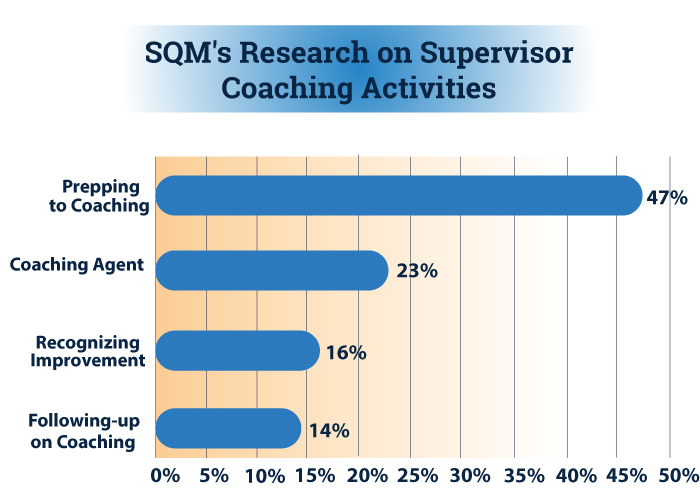
Good supervisors know the way to improve performance is not by exclusively focusing on improving agent productivity. Instead, most good supervisors see that it's on them to coach agents to improve Csat and call resolution and realize a higher call center ROI. They believe that by effectively focusing on Csat and call resolution by coaching, you will reduce repeat calls due to customers trying to resolve the same inquiry or problem. Reducing repeat calls will reduce operating costs and increase customer retention, thus making the company more profitable. The focus on improving Csat and call resolution versus agent productivity has a much higher ROI.
Supervisor coaching effectiveness for helping agents improve Csat and call resolution needs to be measured and acted upon to make any necessary improvement. The following are supervisor coaching effectiveness areas to measure that are provided in our mySQM™ Customer Service QA software:
- Average coaching time and frequencies
- % of monthly agent coaching sessions conducted
- Coaching activities (i.e., prep, coach, recognize, and follow-up)
- % of agents for each supervisor that increased Csat
- Average Csat performance for each supervisor
- Monthly trends of Csat by supervisor
- SoE, root causes, Mot, and behavior trends
- Agent, team, call type, LoB, call center Csat trends
- % of action alerts that where an agent was the SoE
Quick Related Links
First Call Resolution Comprehensive Guide Customer Satisfaction Comprehensive Guide Agent Coaching Customer Quality Assurance VoC Closed-loop Good to Great Customer Service
